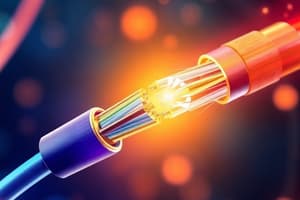Podcast
Questions and Answers
Which of the following is NOT an example of a radio wave?
Which of the following is NOT an example of a radio wave?
- FM radio
- Infrared communication (correct)
- Cordless phones
- Television
Microvave transmissions can travel around obstacles.
Microvave transmissions can travel around obstacles.
False (B)
What is defined as the number of waves passing through an area per unit time?
What is defined as the number of waves passing through an area per unit time?
frequency
Infrared radiation has frequencies between _____ and _____ THz.
Infrared radiation has frequencies between _____ and _____ THz.
Match the following wave types with their primary uses:
Match the following wave types with their primary uses:
What is a major advantage of using fiber optic cables?
What is a major advantage of using fiber optic cables?
Coaxial cables are less expensive than twisted pair cables.
Coaxial cables are less expensive than twisted pair cables.
What is the primary component of a fiber optic cable's core?
What is the primary component of a fiber optic cable's core?
Fiber optic cables are less prone to _______.
Fiber optic cables are less prone to _______.
Which of the following is a disadvantage of fiber optic cables?
Which of the following is a disadvantage of fiber optic cables?
Any fault in a fiber optic cable affects only the specific section of the network it connects.
Any fault in a fiber optic cable affects only the specific section of the network it connects.
Match the advantages and disadvantages of coaxial and fiber optic cables:
Match the advantages and disadvantages of coaxial and fiber optic cables:
Radio waves can pass through _______ like walls.
Radio waves can pass through _______ like walls.
Study Notes
Coaxial Cable
- High-speed data transmission capability.
- Enhanced shielding offers superior protection compared to twisted pair cables, leading to advanced bandwidth utilization.
- More expensive than twisted pair cables.
Fiber Optic Cable
- Entire network failure occurs with any fault in the cable.
- Core consists of numerous light-transmitting materials like glass, plastic, or silica.
- Core is surrounded by a protective shield to prevent intrusion.
- Plastic coating safeguards optical fibers against electromagnetic interference, temperature extremes, and physical damage.
Advantages of Fiber Optic Cable
- Provides significantly higher bandwidth with data transmitted in light form, enabling faster signal conveyance.
- Effective for long-distance data transport.
- Higher reliability due to resistance to temperature fluctuations.
- Lightweight and thinner design allows for better stress resistance.
- Less susceptible to noise interference.
Disadvantages of Fiber Optic Cable
- Higher cost compared to other types of cables.
- Requires regular and extensive maintenance.
- Complex connectivity with other devices.
- Fragility makes them prone to breakage.
- Difficulty in installation due to delicate structure.
Unguided Media
- Use of electromagnetic waves for signal transmission without physical connections, often referred to as wireless communication.
Radio Waves Transmission
- Electromagnetic waves that propagate through open space in all directions, ranging from 3 kHz to 300 GHz.
- Low frequency allows penetration through walls, facilitating signal reception indoors.
- Common applications include FM radio, cordless phones, and television broadcasts.
Microwaves Transmission
- Frequencies range from 1 GHz to 300 GHz, requiring a direct line of sight between devices for effective communication.
- Used in various applications like radio navigation, point-to-point communications, satellite communications, and mobile phone communications.
Infrared Waves Transmission
- Operate in the frequency range of 300 GHz to 400 THz, suitable for short-distance communication.
- High frequency prevents penetration through walls.
- Common uses include remote control devices, data transfer between mobile devices, and computer-to-phone data communication.
Studying That Suits You
Use AI to generate personalized quizzes and flashcards to suit your learning preferences.
Description
Explore the pros and cons of coaxial and fiber optic cables. Understand how coaxial cables offer high-speed data transmission with advanced shielding and bandwidth, but also come with higher costs and network vulnerabilities. Learn about the construction of fiber optic cables and the implications of faults in the network.




